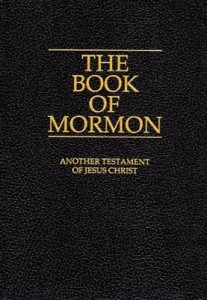The official name of the Mormon Church is The Church of Jesus Christ of Latter-day Saints. Why the term “Mormon,” then? The nickname was given to the Church and its members from the name of one of its books of scripture: the Book of Mormon. Many people don’t know a lot about the Book of Mormon. The book stands as another testament of Christ. It’s a record of the Americas’ ancient, Christian inhabitants and of Christ’s dealings with them. It contains the fullness of the gospel of Jesus Christ. The book is a companion to the Bible, clarifiying its doctrines and unfolding truths which were lost over time.
 Like the Bible, the Book of Mormon is not the work of one person, but is compiled from records kept by many people over a long period of time. This record was kept by the prophets of the ancient inhabitants of the Americas over hundreds of years. Mormon, though one of the contributing record keepers, is not the writer of the book, but is its abridger. He took the most important pieces of history from many records to make what we have today.
Like the Bible, the Book of Mormon is not the work of one person, but is compiled from records kept by many people over a long period of time. This record was kept by the prophets of the ancient inhabitants of the Americas over hundreds of years. Mormon, though one of the contributing record keepers, is not the writer of the book, but is its abridger. He took the most important pieces of history from many records to make what we have today.
The Book of Mormon contains the history of two main groups: the Jaredites, who were led to the Americas at the time of the Tower of Babel, and the Lehites, who were led to the Americas from Jerusalem before its destruction in 600 B.C. Both groups were led by God, and both their records show His dealings with the people. The Lehites quickly divided into two groups, the Lamanites and the Nephites, which remained fairly distinct until the complete destruction of the Nephites in about 400 A.D.
Though the Jaredites came to the Americas far earlier than the Lehites, they eventually destroyed each other because they fell away from keeping the commandments of God. They literally destroyed each other through war, but a record of theirs was found and translated by the Nephites and was added to the Nephites’ record by Mormon when he was abridging the history of his own people.
The Book of Mormon is predominantly the history of the Nephites. The Nephites recorded the fullness of the gospel of Christ, with all its doctrines. The first concern of the book is recording doctrine, but it has some historical elements as well, especially the history of wars between the Nephites and the Lamanites.
The Book of Mormon focuses on the blessings God sends to His people when they obey His commandments, as well as the curses which come if they fail to obey. After His resurrection, Christ visited the Nephites and Lamanites in the Americas. He reestablished His Church there just as he had in Jerusalem before His crucifixion.
After He left, the Nephites and Lamanites lived in a golden age of peace for several generations. But, with every generation, the people remembered Christ less, and the peace eventually broke. Four centuries after Christ, the Nephites were completely destroyed by the Lamanites because of their wickedness. The Lamanites were also wicked, but they had not had as much knowledge as the Nephites had possessed in the gospel, therefore they were not punished as harshly.
Mormon, the book’s abridger, was slain in one of the last battles between the Nephites and Lamanites. His son, Moroni, wrote a short record at the very end of the book and then buried it to keep the Lamanites from destroying it. Nearly 1500 years later, as an angel, Moroni appeared to Joseph Smith and told him about the Nephite record, written on golden plates. Joseph translated the Book of Mormon into English, by power and authority from God, and published it so the world could have another testament of Jesus Christ.
